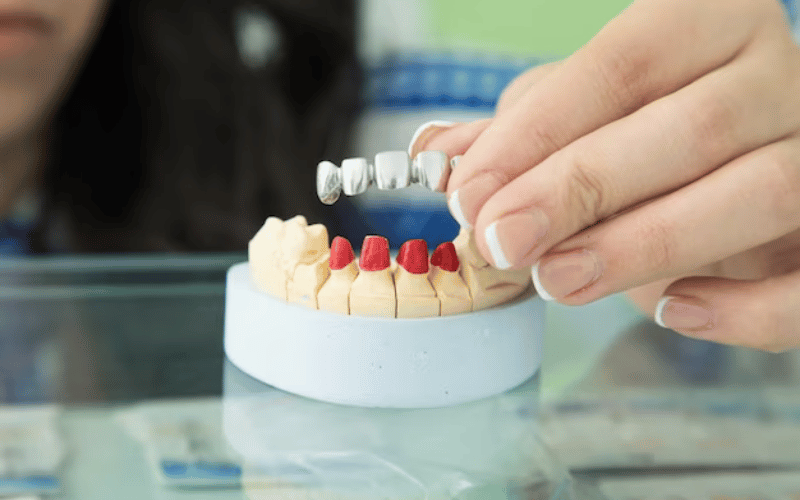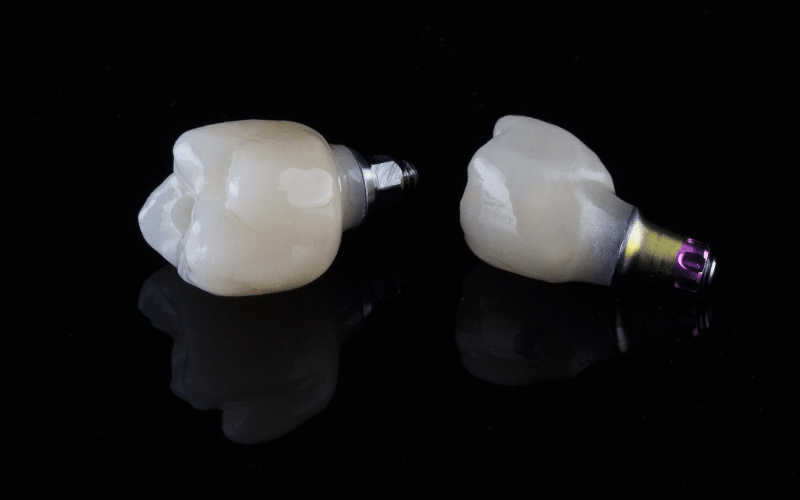


Implant bridges are dental prosthetics that replace missing teeth by anchoring to implants surgically embedded in the jawbone. Unlike traditional bridges, which rely on adjacent teeth for support, implant bridges offer stability and prevent bone loss.
They consist of artificial teeth supported by titanium implants, ensuring durability and natural-looking aesthetics. This treatment restores oral function, improves chewing ability, and enhances overall oral health.
Implant bridges are suitable for individuals with one or more missing teeth and provide a long-term solution for tooth loss, promoting confidence in speech and appearance while preserving jawbone structure and facial contours.
Benefits of Implant Bridges
1. Stability: Implant bridges offer unparalleled stability by anchoring securely to the jawbone, providing a solid foundation for chewing and speaking without slippage or discomfort.
2. Preservation of adjacent teeth: Unlike traditional bridges, implant bridges do not require adjacent teeth to be altered or used as support, preserving the natural structure and integrity of neighboring teeth.
3. Bone preservation: Implants stimulate the jawbone, preventing bone loss and maintaining facial contours and structure, which can deteriorate over time with missing teeth.
4. Longevity: With proper care, implant bridges can last a lifetime, offering a durable and reliable solution for replacing missing teeth.
5. Aesthetics: Implant bridges provide a natural-looking solution for missing teeth, enhancing smile aesthetics and boosting confidence in social and professional settings.
Types of Materials Used for Implant Bridges
Several materials are utilized for implant bridges, each offering distinct advantages:
1. Porcelain: Porcelain is prized for its natural appearance, mimicking the translucency and color of natural teeth. It’s durable and resistant to staining, making it a popular choice for implant bridges in highly visible areas of the mouth.
2. Zirconia: Zirconia is a strong and biocompatible material that offers excellent durability and aesthetic appeal. It’s resistant to chipping and cracking, making it suitable for implant bridges in areas with high chewing forces.
3. Metal alloys: Some implant bridges incorporate metal alloys such as titanium or cobalt-chromium. These materials provide exceptional strength and stability, particularly in situations where a larger span of teeth needs to be supported.
4. Hybrid materials: Hybrid implant bridges combine different materials, such as a metal framework with porcelain or acrylic overlays. These bridges offer a balance of strength, aesthetics, and affordability.
5. Composite resin: Composite resin bridges are a more affordable option that can be color-matched to natural teeth. While not as durable as porcelain or zirconia, they can be a suitable temporary solution or used in less visible areas of the mouth.
How Do Implant Bridges Work?
Implant bridges function by replacing missing teeth with artificial teeth anchored to dental implants surgically placed in the jawbone. The process typically involves several steps:
1. Consultation and Planning: A thorough examination, including X-rays and scans, helps the dentist assess the patient’s oral health and determine the feasibility of implant placement. A treatment plan is then devised based on the patient’s needs and goals.
2. Implant Placement: In a minor surgical procedure, titanium implant posts are inserted into the jawbone at precise locations where teeth are missing. These implants serve as artificial tooth roots and provide a stable foundation for the bridge.
3. Healing and Osseointegration: Over several months, the implants fuse with the surrounding bone in a process called osseointegration. This integration ensures the implants become firmly anchored in the jawbone, mimicking the natural stability of tooth roots.
4. Abutment Placement: Once osseointegration is complete, abutments—small connector pieces—are attached to the implants. These abutments protrude above the gum line and serve as attachment points for the implant bridge.
5. Bridge Fabrication: Impressions of the patient’s mouth are taken to create a custom-made bridge that fits precisely over the implant abutments. The bridge consists of artificial teeth (pontics) attached to a framework or directly to the abutments.
6. Final Placement: The completed implant bridge is attached to the abutments, either through cementation or screw retention. The bridge is adjusted to ensure proper fit and bite alignment.
7. Follow-Up Care: Patients are advised on proper oral hygiene practices and scheduled for regular check-ups to monitor the health and stability of the implant bridge.
Overall, implant bridges offer a reliable and long-lasting solution for replacing missing teeth, restoring oral function, and enhancing smile aesthetics.
Potential Risks and Complications
1. Infection: Infection at the implant site can occur during or after surgery, leading to complications such as peri-implantitis—a condition where the tissues around the implant become inflamed and infected.
2. Implant Failure: Despite high success rates, implants can fail to integrate with the jawbone (osseointegration) or may become loose over time, requiring removal or replacement.
3. Nerve Damage: Nerve damage during surgery can result in numbness, tingling, or loss of sensation in the lips, tongue, or chin. This is often temporary but can be permanent in rare cases.
4. Bone Loss: Inadequate bone density or improper placement of implants can lead to bone loss around the implants, compromising their stability and requiring additional procedures to address.
5. Prosthesis Complications: Issues with the implant bridge itself, such as fracture, loosening, or improper fit, may arise, necessitating repairs or replacement to maintain function and aesthetics.
In conclusion, Implant Bridges in Beverly Hills offers a transformative solution for replacing missing teeth, restoring oral function, and enhancing smile aesthetics. Under the expertise of Beverly Hills Oral and Facial Surgeons, patients receive meticulous care, from initial consultation to final placement, ensuring optimal results and patient satisfaction.
Despite potential risks and complications, the benefits of implant bridges, such as stability, preservation of adjacent teeth, and longevity, far outweigh the risks. With a commitment to excellence and cutting-edge techniques, Beverly Hills Oral and Facial Surgeon delivers exceptional outcomes, empowering patients to regain confidence in their smiles and overall oral health.




